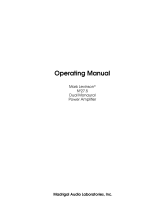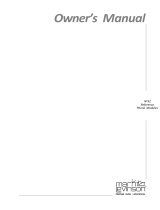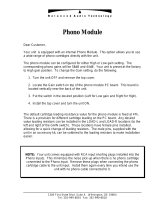Mark Levinson N26 User manual
- Category
- Musical Equipment
- Type
- User manual
This manual is also suitable for

17
Madrigal Audio Laboratories, Inc.
Operating Manual
Mark Levinson
®
Nº26
Dual Monaural
Preamplifier

18
CAUTION
RISK OF ELECTRIC SHOCK
DO NOT OPEN
CAUTION: TO REDUCE THE RISK OF ELECTRICAL SHOCK,
DO NOT REMOVE COVER. NO USER-SERVICEABLE PARTS
INSIDE. REFER SERVICING TO QUALIFIED PERSONNEL.
WARNING: TO REDUCE THE RISK OF FIRE OR ELECTRIC SHOCK,
DO NOT EXPOSE THIS APPLIANCE TO RAIN OR MOISTURE.
The lightning flash with arrowhead symbol, within an equilateral triangle, is intended to alert the
user to the presence of uninsulated “dangerous voltage” within the product’s enclosure that may
be of sufficient magnitude to constitute a risk of electric shock to persons.
The exclamation point within an equilateral triangle is intended to alert the user to the presence of
important operating and maintenance (servicing) instructions in the literature accompanying the
appliance.

19
Important safety instructions
Please read all instructions and precautions carefully and completely before operating your Nº26
Dual Monaural Preamplifier.
1. ALWAYS disconnect your entire system from the AC mains before connecting or disconnecting
any cables, or when cleaning any component.
2. This product is equipped with a three-conductor AC mains power cord which includes an earth
ground connection. To prevent shock hazard, all three connections must ALWAYS be used. If
your electrical outlets will not accept this type of plug, an adapter may be purchased. If an
adapter is necessary, be sure it is an approved type and is used properly, supplying an earth
ground. If you are not sure of the integrity of your home electrical system, contact a licensed
electrician for assistance.
3. AC extension cords are not recommended for use with this product. If an extension cord must
be used, be sure it is an approved type and has sufficient current-carrying capacity to power
this product.
4. NEVER use flammable or combustible chemicals for cleaning audio components.
5. NEVER operate this product with any covers removed.
6. NEVER wet the inside of this product with any liquid.
7. NEVER pour or spill liquids directly onto this unit.
8. NEVER block air flow through ventilation slots or heatsinks.
9. NEVER bypass any fuse.
10. NEVER replace any fuse with a value or type other than those specified.
11. NEVER attempt to repair this product. If a problem occurs, contact your Mark Levinson
®
retailer.
12. NEVER expose this product to extremely high or low temperatures.
13. NEVER operate this product in an explosive atmosphere.
14. ALWAYS keep electrical equipment out of the reach of children.

20
From all of us at Madrigal Audio Laboratories, thank you for choosing the Mark Levinson
®
Nº 26 Dual
Monaural Preamplifier.
A great deal of effort went into the design and construction of this precision device. Used properly, it
will give you many years of enjoyment.

21
Table of contents
Front panel ...................................................................................................1
Rear panel ................................................................................................... 3
Unpacking and placement .......................................................................5
Unpacking .............................................................................................. 5
Placement ............................................................................................. 5
Ventilation .............................................................................................. 5
Voltage selection ........................................................................................6
PLS-226 bottom-panel label .......................................................... 6
Set-up and installation ................................................................................ 7
Connectors and cables ....................................................................... 7
Internal adjustments: line gain ............................................................. 7
Line gain settings ............................................................................ 7
Internal adjustments: phono gain ....................................................... 7
Phono gain settings (high-gain option) ....................................... 7
Phono gain settings (low-gain option) ......................................... 7
Internal adjustments: cartridge loading ............................................. 8
Cartridge loading settings (high-gain option) ............................ 8
Cartridge loading settings (low-gain option) .............................. 8
Internal adjustments: optional load terminals ................................... 8
Terminating the optional load ...................................................... 8
Internal adjustments: varying the input capacitance ...................... 9
Internal adjustments: adjusting the balanced input gain ................ 9
Balanced input gain settings ........................................................ 9
Making the internal adjustments ......................................................... 9
Nº26, internal adjustments ............................................................. 9
Power connection and system activation ....................................... 10
AC power cord polarity ............................................................... 10
Turning off the Nº26 ............................................................................. 10
Care and maintenance ...........................................................................11
Specifications ............................................................................................12
Phono section ...................................................................................... 12
Line section .......................................................................................... 12
Dimensions.................................................................................................13
Dimensions, Nº26, top view.......................................................... 13
Dimensions, Nº26, side view ......................................................... 13
Dimensions, PLS-226, side view .................................................... 14
Dimensions, PLS-226, top view ..................................................... 14

22

1
MONITOR SELECTORRECORD SELECTOR
TAPE 2
CD
TUNER
AUX 1
PHONO/
AUX 2
TAPE 1
MADRIGAL AUDIO LABORATORIES
1
INPUT
SELECTOR BALANCE 1 BALANCE 2
DUAL MONAURAL
PREAMPLIFIER
Nº 26
0° 180° STEREO MONO
DEFEAT
INPUT
MONITOR
TAPE 1
TAPE 2
-1
-2
-3
-4
-5
0dB
+1
+2
+3
+4
+5
-1
-2
-3
-4
-5
0dB
+1
+2
+4
+5
OUTPUT
LEVEL
+3
3 4 5 6 6
OFF
1
2
3
4
5
6
7
8
9
10
2 7
Front panel
1 RECORD SELECTOR
Selects between the program source (selected via the INPUT
SELECTOR), and either of two tape monitor inputs (selected via the
MONITOR SELECTOR).
In the DEFEAT position, the tape outputs are disconnected.
In the INPUT position, the tape outputs are connected while still
monitoring the selected source.
In the MONITOR position, the selected tape machine can be
monitored without affecting the signal at the tape outputs.
Note: Because of the switching arrangement employed in
the Nº26, we recommend that while making a critical
recording you don't operate the RECORD SELECTOR switch.
If you wish to monitor the signal from tape, set the RECORD
SELECTOR to MONITOR and use your tape machine's monitor
switch to switch between input and tape.
20°/180°
In the 0° position, the signal at the main outputs is in phase with the
input signal. In the 180° position, the output signal is inverted 180
degrees. This allows you to optimize your system's sonic
performance based on recording/mastering processes used for a
specific program.
The 0°/180° switch doesn't affect the tape outputs.
3 MONITOR SELECTOR
When the RECORD SELECTOR is in the MONITOR position, this selects
between the TAPE 1 and TAPE 2 inputs.
4 INPUT SELECTOR
Selects one of the six inputs: CD, TUNER, AUX 1, PHONO/AUX 2
(depending on the installed option), TAPE 1, or TAPE 2.

2
5 OUTPUT LEVEL
Adjusts volume at the main outputs.
The OUTPUT LEVEL control doesn't affect the tape outputs.
Note: In some systems, particularly those with high-efficiency
loudspeakers, high-gain amplifiers, and balanced
interconnections, it's possible that you may hear some low-
level sound through your loudspeakers
even with the Nº26's
OUTPUT LEVEL control set to OFF
.
If this occurs with all inputs, reduce the
line gain
(via the
internal switches). If this occurs only when listening to the
source connected to the Nº26's optional balanced input,
reduce the
balanced input gain
(via the internal switches).
See "Set-up and installation."
6 BALANCE 1, BALANCE 2
Adjusts volume at the main outputs.
The BALANCE controls don't affect the tape outputs.
7 STEREO/MONO
Selects between monaural or stereo mode at the main output.
The STEREO/MONO switch doesn't affect the tape outputs.

3
OPTIONAL BALANCED INPUT
PUSH PUSH
BALANCED OUTPUT
RL
RL
POWER
SUPPLY
INPUT
DUAL MONAURAL
PREAMPLIFIER
Nº 26
DESIGNED AND MANUFACTURED
IN U.S.A. BY
MADRIGAL
AUDIO LABORATORIES INC.
S/N:
RLRLRL
RL RL RL
MAIN OUT TAPE 2 OUT TAPE 1 OUT
TUNER TAPE 2 IN TAPE 1 IN
CD AUX 1 PHONO/AUX 2
AUX 2
10
6
3
1
5 5 7 8 9
2 4 4
11
Rear panel
Disconnect all associated equipment from the AC mains BEFORE
making any signal connections and applying power to the Nº26/PLS-
226.
1 BALANCED OUTPUT
If your power amplifier is equipped with balanced input
connectors, it's best to connect it to the Nº26 via these connectors,
particularly if long cable lengths are required.
Connect the right-channel and left-channel BALANCED OUTPUT of
the Nº26 to the appropriate balanced inputs of the power
amplifier.
The pin assignments of these XLR-type male outputs are:
Pin 1: Signal ground
Pin 2: Signal + (non-inverting)
Pin 3: Signal – (inverting)
Connector ground lug: chassis ground
Refer to your power amplifier's operating manual to verify that the
pin assignments of its input connector correspond to the Nº26. If
not, wire the cable so that the appropriate output pin connects to
the equivalent input pin.
2 MAIN OUT
Connect these outputs to the right-channel and left-channel
inputs of your power amplifier or electronic crossover.
These outputs are affected by the OUTPUT LEVEL control on the
front panel of the Nº26.
3 TUNER
Accepts right-channel and left-channel signal leads from a tuner
or other line-level source equipment.
PRECAUTION
PUSH
21
3

4
4 TAPE 1 OUT, TAPE 2 OUT
Connect these outputs to the right-channel and left-channel tape
inputs of your tape machine.
5 TAPE 1 IN, TAPE 2 IN
Accept right-channel and left-channel signal leads from the tape-
output connectors of a tape machine. These inputs can also be
used with other line-level source equipment.
These outputs are unaffected by the OUTPUT LEVEL control on the
front panel of the Nº26.
6 POWER SUPPLY INPUT
Accepts one end of the DC cable that connects the Nº26 to the
PLS-226.
7CD
Accepts right-channel and left-channel balanced signal leads
from a CD player or other line-level source equipment.
8 AUX 1
Accepts right-channel and left-channel signal leads from line-level
source equipment.
9 PHONO/AUX 2
If your Nº26 is equipped with the phono option, connect your
turntable's right-channel and left-channel signal leads to these
inputs.
If your Nº26 isn't equipped with a phono option, these inputs will
accept signal leads from any line-level source equipment.
10 Ground binding post
Connect your tonearm's ground lead to this binding post.
11 OPTIONAL BALANCED INPUT
If your Nº26 is equipped with the balanced input option, connect
the right-channel and left-channel balanced line-level signal leads
from source equipment with balanced output.
The pin assignments of these XLR-type female input connectors
are:
Pin 1: Signal ground
Pin 2: Signal + (non-inverting)
Pin 3: Signal – (inverting)
Connector ground lug: chassis ground
Refer to the operating manual of your balanced-output line-level
source to verify that the pin assignments of its output connector
correspond to the Nº26. If not, wire the cable so that the
appropriate output pin connects to the equivalent input pin.
12
3

5
Unpacking and placement
Unpack your Nº26 Preamplifier and PLS-226 Power Supply, and keep all
packing materials for future transport. Remove all accessories from the
cartons.
Carefully inspect the product for damage and flaws. If you find any,
see your Mark Levinson dealer immediately.
Place the Nº26 as close as possible to the source equipment, thus
keeping interconnect cabling as short as possible. It may be placed
on a shelf or in a cabinet where it's convenient to operate.
A one-meter DC cable is provided to connect the PLS-226 to the Nº26.
This allows you to place the PLS-226 so that it won't induce hum in the
Nº26 and other sensitive components. If you're placing the Nº26 and
PLS-226 adjacent to each other, place the PLS-226 to the right of the
Nº26 (viewed from the front). You should also place associated
equipment so that it doesn't induce hum in the Nº26 and other
sensitive components.
Be sure to allow 3 to 4 inches of clearance above both the Nº26 and
the PLS-226, to allow heat dissipation through air circulation.
Drawings are included in this manual to facilitate special installations
and custom cabinetry (see "Dimensions").
For your protection, review "Important safety instructions" before you
install your Nº26.
PRECAUTION
Unpacking
Placement
Ventilation

6
Voltage selection
The PLS-226 is factory-set (internally) for 100V, 120V, 200V, 220V, or
240V AC mains operation @ 50 or 60Hz. Make sure that the label on
the bottom of the PLS-226 indicates the correct AC operating voltage
for your location.
PLS-226 POWER SUPPLY
WARNING: BEFORE ATTEMPTING TO
OPERATE THIS DEVICE, REFER TO
OWNER'S MANUAL FOR PROPER
OPERATING INSTRUCTIONS AND SAFETY
PRECAUTIONS. HAZARDOUS VOLTAGE
AVAILABLE INSIDE; DISCONNECT AC~
MAINS CABLE BEFORE REMOVING COVER.
AC INPUT
OPERATING VOLTAGE:
90 – 110VAC~
105 – 125VAC~
180 – 220VAC~
210 – 240VAC~
230 – 250VAC~
~50 – 60HZ
SERIAL NO.
FUSES:
100 – 120VAC~
2A SLO–BLO 250VAC 3AB
200 – 240VAC~
1A SLO–BLO 250VAC 3AB
DESIGNED AND MANUFACTURED IN U.S.A. BY
MADRIGAL AUDIO LABORATORIES INC.
MAINS
Voltage
indication
DC OUTPUTS
PLS-226 bottom-panel
label
If the voltage indicated is incorrect, see your Mark Levinson dealer.
If you wish to change the AC operating voltage of the Nº26/PLS-226,
see your Mark Levinson dealer.
The Nº26/PLS-226 can be powered by a normal 15-ampere AC mains
line. If other devices are also powered from the same AC line, their
additional power consumption must be taken into account.

7
Set-up and installation
The Nº26 incorporates RCA-type and XLR-type connectors for audio
signal input and output.
The Madrigal-designed RCA-type connectors used for single-ended
audio interconnection are a great improvement over ordinary RCA-
type connectors. The gold-plated XLR-type connectors employed are
of European design, and are made to professional standards.
When connecting the Nº26 to source equipment and power
amplifiers, we recommend Madrigal Audio Laboratories HPC
Interconnect Cable. HPC is available in various lengths, terminated
with RCA, XLR, and Camac connectors. See your Mark Levinson
dealer for more information.
The Nº26 offers internal gain adjustment of the line amplifiers, in 6dB
steps via two four-pole miniature rocker switches (one for each
channel). These switches have been factory-adjusted at the lowest
gain position (6dB of line gain in single-ended operation, and 12dB of
line gain in balanced operation). In practice, you should have enough
gain so that normal listening is possible with the OUTPUT LEVEL set at
approximately 6.
If you wish to increase the line gain, see "Making the internal
adjustments;" refer to the table below for the proper switch positions
for each gain setting.
Switch Gain
#1 #2 #3 #4 Single-Ended Output Balanced Output
On On Off Off 18dB 24dB
Off On On Off 12dB 18dB
Off Off On On 6 dB 12dB
The Nº26 is available with either a high-gain or low-gain phono option.
Each option offers two internally adjustable gain settings via two two-
pole miniature rocker switches, one for each channel. The high-gain
and low-gain phono options have been factory-adjusted at the lowest
gain settings (58dB and 38dB, respectively).
If you wish to increase the gain, see "Making the internal adjustments;"
refer to the tables below for the proper switch positions for each gain
settings.
Switch
#1 #2 Gain Nominal Cartridge Output (3.54 cm/sec)
On Off 58dB .2mV - .6mV
Off On 64dB .2mV and Lower
Switch
#1 #2 Gain Nominal Cartridge Output (3.54 cm/sec)
On Off 38dB Greater than 2.0mV
Off On 44dB 2.0mV and Lower
Connectors and cables
Line gain settings
Internal adjustments:
phono gain
Phono gain settings
(high-gain option)
Phono gain settings
(low-gain option)
Internal adjustments:
line gain

8
The high-gain and low-gain phono options offer internally selectable
cartridge loading via two four-pole miniature rocker switches, one for
each channel. The high-gain and low-gain options have been factory-
adjusted at 825Ω and 47KΩ, respectively.
If you wish to change the factory-adjusted cartridge loading, see
"Making the internal adjustments;" refer to the table below for the
proper switch positions for each load setting.
Switch 10KΩ 825Ω 100Ω 30Ω Optional
#1 Off On Off Off Off
#2 Off Off On Off Off
#3 Off Off Off On Off
#4 Off Off Off Off On
Switch 47KΩ 22KΩ 10KΩ 825Ω Optional
#1 Off On Off Off Off
#2 Off Off On Off Off
#3 Off Off Off On Off
#4 Off Off Off Off On
Resistance values other than those listed above can be
accommodated via the optional load terminals. Load resistors can be
inserted into these terminals, allowing virtually any load desired.
Cartridge loading settings
(high-gain option)
Internal adjustments:
cartridge loading
Cartridge loading settings
(low-gain option)
Optional load
component
Solder
Solder
PC board
See "Making the internal adjustments;" refer to the "Cartridge loading
settings" tables for the proper switch positions for the optional load.
Because the inherent input resistance (all switches off) is in parallel with
the optional load terminals, use this formula to calculate the actual
resistor needed:
R = 1/ (1/RD - X)
RD = Desired resistance in ohms
X = 0.00002 for Low-gain Phono Option,
0.0001 for High-gain Phono Option
Note: We recommend precision metal-film resistors; see your
Mark Levinson dealer.
Internal adjustments:
optional load terminals
Terminating the
optional load

9
If you wish to vary the input capacitance of the phono option to
obtain the optimal value for a particular cartridge, a capacitor may
also be inserted into the optional load terminals (see "Terminating the
optional load" and "Making the internal adjustments").
Because the inherent input capacitance (all switches off) is in parallel
with the optional load terminals, use the following formula to calculate
the actual capacitor needed.
C = C
R
- C
T
- C
P
C = The capacitor value
C
R
= Recommended capacitance value
C
T
= Tonearm capacitance including leads
C
P
= Preamplifier inherent shunt capacitance
(Low-gain phono option = 100pf; high-gain phono option = 1000pf)
Note: We recommend high-quality polypropylene, polystyrene
or Teflon capacitors; see your Mark Levinson dealer.
The Nº26's optional balanced input module allows you to adjust the
input gain. If you wish to adjust the balanced input gain, see "Making
the internal adjustments;" refer to the table below for the proper switch
positions for each gain setting.
Switch –1.1dB –7.1dB
#1 Off On
#2 On Off
#3 Off On
#4 On Off
1. Make sure all associated equipment is disconnected from the AC
mains, and that the PLS-226 is disconnected from the AC mains.
Internal adjustments:
varying the input
capacitance
Internal adjustments:
adjusting the
balanced input gain
Balanced input
gain settings
Making the
internal adjustments
OFF
1234
O
F
F
12
O
N
Phono gain
(right channel)
Cartridge loading OR
balanced input gain
(right channel)
Line gain
(left channel)
Phono gain
(left channel)
Cartridge loading OR
balanced input gain
(left channel)
Line gain
(right channel)
Optional load pins
Optional load pins
Nº26, internal adjustments

10
2. Using a 3/32" Allen key, remove the four 4-40 socket-head cap
screws securing the end caps on the read of the Nº26's chassis.
3. Using a Phillips screwdriver, remove the four 4-40 screws securing
the Nº26's top plate. Carefully slide the top plate to the rear and
remove it.
4. Adjust the gain switches (using a ballpoint pen or similar
instrument) and install optional loads as desired.
5. Reassemble the Nº26.
Be sure all associated equipment is disconnected from the AC mains.
After making all signal connections and internal adjustments, connect
the DC cable to either of the DC connectors on the rear panel of the
PLS-226.
Connect the other end of the DC cable to the POWER SUPPLY INPUT
connector on the rear panel of the Nº26.
Connect the AC cord to the male IEC connector on the rear panel of
the PLS-226, then connect the AC cord to the AC mains.
To PLS-226 To AC mains
1
3
2
1
2
3
1 = Line (hot)
2 = Neutral
3 = Earth ground
AC power cord polarity
The LEDs on the PLS-226 and Nº26 will light. Allow the Nº26's circuitry to
stabilize for 1 to 2 minutes, then connect all associated equipment to
the AC mains and activate it.
For optimal sonic performance and longevity, the Nº26/PLS-226 is
designed to remain powered at all times (a power-on/power-off
switch isn't provided).
Before connecting or disconnecting the PLS-226 from the AC
mains, be sure that the Nº26's OUTPUT LEVEL is set to OFF (the
lowest position), and that your power amplifiers are turned off.
Turning off the Nº26
Power connection and
system activation

11
Care and maintenance
To remove dust from the cabinet of the Nº26, use a feather duster. To
remove dirt and fingerprints, we recommend isopropyl alcohol and a
soft cloth.

12
Specifications
The correlation between published specifications and sonic quality is
unreliable. A list of numbers reveals virtually nothing. All technical
measurements must be subject to qualitative as well as quantitative
interpretation.
Measurements of the Nº26 yield excellent results by any standards.
However, only those specifications that apply to its actual operation
are included here.
■ Power consumption: 50W maximum, depending on options
■ Mains voltage: 100V, 120V, 200V, 220V, or 240VAC @ 50/60Hz
■ Overall dimensions: See "Dimensions"
■ Shipping weight (2 boxes): 30 lbs. (13.6kg)
■ Connector complement: 18 female RCA-type connectors
2 XLR-type female connectors
2 XLR-type male connectors
1 binding post (turntable ground)
3 nine-pin connectors
1 IEC mains connector
■ Gain: Selectable (see "Set-up and installation")
■ Moving-magnet phono option: 38dB, 44dB
■ Moving-coil phono option: 58dB, 64dB
■ Input impedance: Selectable (see "Set-up and installation")
■ Output impedance: 10Ω
■ Maximum output (TAPE output): 6V
■ Recommended load (TAPE outputs): 10KΩ or greater
■ Gain: Selectable (see "Set-up and installation")
■ Single-ended: 6dB, 12dB, 18dB
■ Balanced: 12dB, 18dB, 24dB
■ Input impedance: 14KΩ shunted by 220pf
■ Maximum output (MAIN outputs): 6V
■ Recommended load (TAPE outputs): 600Ω or greater
For more information, see your Mark Levinson dealer, or contact:
Madrigal Audio Laboratories, Inc.
2081 South Main Street (Route 17), P.O. Box 781
Middletown, Connecticut 06457 USA
Telephone (203) 346-0896
(FAX (203) 346-1540
Phono section
Line section
If purchased in North America, this Mark Levinson product’s warranty is owner-transferable.
Warranty conditions are valid only in the country where the product was originally purchased.
For warranty information and conditions on products purchased outside of North America,
contact your local dealer or regional distributor.

13
13-1/8"
(333.4)
17-1/2"
(444.5)
10-1/2"
(266.7)
1-1/4"
(31.8)
3/4" dia.
(19.1)
3/8"
(9.5)
7/64"
(2.5)
15-3/64"
(382.0)
17-19/64"
(439.4)
1-1/8"
(28.7)
7/16"
(11.1)
7/64"
(2.5)
2-3/4"
(69.9)
2-35/64"
(64.8)
Dimensions
Dimensions, Nº26, side view
Dimensions, Nº26, top view

14
13-1/8"
(333.4)
7-39/64"
(193.0)
10-1/2"
(266.7)
1-1/4"
(31.8)
3/4" dia.
(19.1)
3/8"
(9.5)
7/64"
(2.5)
7-13/32"
(187.9)
1-1/8"
(26.7)
7/16"
(11.1)
7/64"
(2.5)
2-3/4"
(69.9)
2-35/64"
(64.8)
5-9/64"
(130.6)
Dimensions, PLS-226,
top view
Dimensions, PLS-226,
side view
Page is loading ...
-
 1
1
-
 2
2
-
 3
3
-
 4
4
-
 5
5
-
 6
6
-
 7
7
-
 8
8
-
 9
9
-
 10
10
-
 11
11
-
 12
12
-
 13
13
-
 14
14
-
 15
15
-
 16
16
-
 17
17
-
 18
18
-
 19
19
-
 20
20
-
 21
21
Mark Levinson N26 User manual
- Category
- Musical Equipment
- Type
- User manual
- This manual is also suitable for
Ask a question and I''ll find the answer in the document
Finding information in a document is now easier with AI
Related papers
-
 Mark Levinson 27.5 Operating instructions
Mark Levinson 27.5 Operating instructions
-
 Mark Levinson 32 User manual
Mark Levinson 32 User manual
-
 Mark Levinson 500H User manual
Mark Levinson 500H User manual
-
 Mark Levinson N383 User manual
Mark Levinson N383 User manual
-
 Mark Levinson No532 User manual
Mark Levinson No532 User manual
-
 Mark Levinson 28 User manual
Mark Levinson 28 User manual
-
 Mark Levinson N40 User manual
Mark Levinson N40 User manual
-
 Mark Levinson N40 Owner's manual
Mark Levinson N40 Owner's manual
-
 Mark Levinson 53 User manual
Mark Levinson 53 User manual
-
 Mark Levinson N 331 User manual
Mark Levinson N 331 User manual
Other documents
-
 Balanced Audio Technology VK-P3 Operating instructions
Balanced Audio Technology VK-P3 Operating instructions
-
 Balanced Audio Technology Phono Module Operating instructions
Balanced Audio Technology Phono Module Operating instructions
-
Meiko Topic brief Operating instructions
-
Harman Mark Levinson No526/No523 Dual-Monaural Preamplifier User manual
-
 Aqvox PHONO 2 CI Owner's manual
Aqvox PHONO 2 CI Owner's manual
-
Crown SL-1 Owner's manual
-
 Balanced Audio Technology VK-P10SE User manual
Balanced Audio Technology VK-P10SE User manual
-
McIntosh MP1100 Owner's manual
-
 Sunfire Classic Vacuum Tube Control Center User manual
Sunfire Classic Vacuum Tube Control Center User manual
-
Biamp 19 Series Mixing Console Models 119 and 619 User manual



































